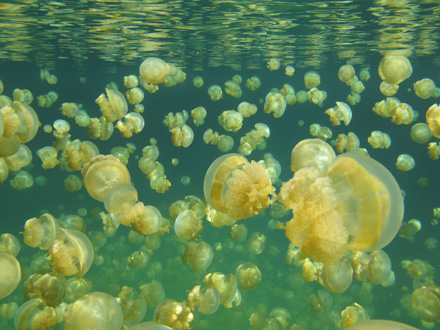 If you want a beautiful example of very rapid recent evolution there are few better than the beautiful golden jellyfish, Mastigias cf. papua etpisoni which inhabits Jellyfish Lake (Ongeim'l Tketau) on Eil Malk island in the tiny Micronesian state of Palau in the Pacific.
If you want a beautiful example of very rapid recent evolution there are few better than the beautiful golden jellyfish, Mastigias cf. papua etpisoni which inhabits Jellyfish Lake (Ongeim'l Tketau) on Eil Malk island in the tiny Micronesian state of Palau in the Pacific. Eil Malk island is one of a group of islands known as the Rocky Islands in Palau's Southern Lagoon, the remnants of a Miocene coral reef. Jellyfish lake, like several other similar lakes, is connected to the surrounding lagoon only through the porous rock of the island. This means that, so far as the marine environment is concerned, Ongeim'l Tketau is an isolated micro-environment.
It has been so since 12,000 years ago when geological evidence shows was the last time the ocean level was high enough for the lake to be directly connected to the surrounding ocean. The effect of this was to reset the clock so to speak, so far as biodiversity is concerned. At that point, every species then present in the lake became effectively isolated from it's parent population and a population of (probably) the spotted jellyfish Mastegias papua became isolated from those in the surrounding lagoon. It mimics the sort of experiment biologists would love to do on this scale and over this time-span.
The lake is one of about 200 known world-wide in which the water is stratified into distinct layers which do not mix. In Jellyfish lake, there is a top layer which is oxygenated and which receives sunlight, and an anoxic dark layer which is rich in hydrogen sulphide from the decaying remains on the lake bed. At the interface between these layers (known as a chemocline) there lives a group of photosynthesising purple sulphur bacteria.
Like the spotted and several other related jellyfish, golden jellyfish rely on single-celled, photosynthesising algae, which live symbiotically in cells in their 'clubs', for most of their food. The algae receive protection and are taken to the sunlight and supplied with all their nutrients by the jellyfish and supply the jellyfish with sugar in return. Juvenile jellyfish quickly build up their population of algae from the micro-organisms they take in whilst feeding in the normal jellyfish way.
In just that short time, Mastigias cf. papua etpisoni has undergone considerable evolution. Incidentally, the 'cf.' in the scientific name of the golden jellyfish is because it's not certain that it is a subspecies of M. papua and not of one of several such closely related species. M. papua seems the most likely candidate because it is common locally.
And this problem serves to highlight the degree of separation that a mere 12,000 years of isolation in a unique environment has produced. The changes are not just morphological either.
Golden jellyfish have unique daily pattern of migration within Jellyfish lake.
- Night - For about 14 hours a day the jellyfish make repeated vertical excursions between the surface and the chemocline in the western basin possibly to acquire nitrogen and other nutrients from near the chemocline for their symbiotic algae.
- From early morning to about 0930 - The jellyfish move from center of western basin to the eastern basin
- From early afternoon to about 1530 - The jellyfish move from eastern basin to near western end of lake
- As the sun sets - The jellyfish move briefly eastward from western end to western basin where they remain through the night
Spotted jellyfish also exhibit migratory behaviour in the lagoon moving with the sun as it moved across the lagoon, but it is nothing as complex as that of the golden jellyfish.
It is thought that the difference is caused by evolutionary change driven by the jellyfish-eating anemones Entacmaea medusivora that inhabit the eastern regions of Jellyfish Lake. The jellyfish avoid shadows and in the morning with the shadows on the eastern end the jellyfish also avoid the anemones. By moving east to west in the early afternoon the jellyfish avoid the time of day when the setting sun would eliminate shadows on the lake in the eastern end and thereby avoid the anemones in the afternoon.
So we see not only a striking morphological change but also a change in life-style in as little as 12,000 years, all driven by an environmental change which first isolated a founder population and then moulded it to suit the particular micro-environment which ensued.
For me, understanding how evolution produces this with a few easy to understand 'rules' makes these little snippets of information about life on earth one of the great joys of living. Who could not want to understand what has created this amazingly beautiful and complex planet?
What a waste of a life to spend it finding ways to deny all that wonder and enjoyment because of the mind-numbing theophobia of religious superstition. What disgusting specimens of human life are those parasites who promulgate this superstitious phobia and encourage the scientific ignorance that facilitates it, simply to create and maintain a credulous market to feed off and something behind which to hide their politics of racism, hate, greed and selfishness.


No comments:
Post a Comment
Obscene, threatening or obnoxious messages, preaching, abuse and spam will be removed, as will anything by known Internet trolls and stalkers, by known sock-puppet accounts and anything not connected with the post,
A claim made without evidence can be dismissed without evidence. Remember: your opinion is not an established fact unless corroborated.